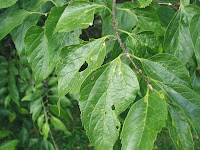Celtis, celtis occidentalis
 Leaves and fruit of common hackberry (celtis occidentalis). Berries are indicated with arrows. Image from Wikipedia. Leaves and fruit of common hackberry (celtis occidentalis). Berries are indicated with arrows. Image from Wikipedia. |
The berries are also eaten by gamebirds such as wild turkey, quail, doves and pigeons. And as you might expect, squirrels eat the berries, and so do beaver, possum, raccoons, skunks, gray fox, wood rats, and (in Texas) the ring-tailed cat.
Some species of hackberry trees are called sugarberries or honeyberries which helps to explain why the berries were used by the Native Americans and why people still use hackberries for jelly and wine.
One or more of the eight species of hackberries are found in nearly every state from the Rocky Mountains east. In western Kentucky where I live, our hackberries are celtis occidentalis or common hackberry.
For us, common hackberry is usually a medium to large tree, but in less hospitable conditions, it may not attain such size. It's a versatile tree that tolerates many growing conditions from wet to dry, but it doesn't like permanently swampy areas and it doesn't like acidic soil.
Forestry guide Steve Nix at About.com cautions that common hackberry produces surface roots that can interfere with lawn mowing and raise sidewalks. Think carefully about where to plant the tree, but do consider it because of its great wildlife value.
Cultivars are available from nurseries, or you can transplant a seedling from the wild in early spring or late fall. Starting them from seed requires some patience -- if planted outside, the seeds germinate in 1 to 2 years.
------------
Related:
Hackberry information page in the USDA Plants Database
Hackberry Emperor butterfly
* American Wildlife and Plants by Alexander Martin, Herbert S. Zim, and Arnold L. Nelson, published by McGraw Hill Book Company in 1951. The book is out of print, but it's often available from used book dealers.


 "The power to recognize trees at a glance without examining their leaves or flowers or fruit as they are seen, for example, from the car-window during a railroad journey, can only be acquired by studying them as they grow under all possible conditions over wide areas of territory. Such an attainment may not have much practical value, but once acquired it gives to the possessor a good deal of pleasure which is denied to less fortunate travelers."
"The power to recognize trees at a glance without examining their leaves or flowers or fruit as they are seen, for example, from the car-window during a railroad journey, can only be acquired by studying them as they grow under all possible conditions over wide areas of territory. Such an attainment may not have much practical value, but once acquired it gives to the possessor a good deal of pleasure which is denied to less fortunate travelers."
1 comments -- please add yours:
There are so many great, wildlife friendly native trees and I appreciate you introducing me to another one.
Post a Comment